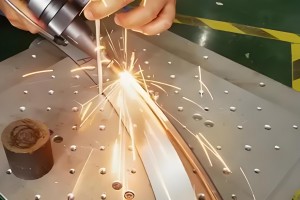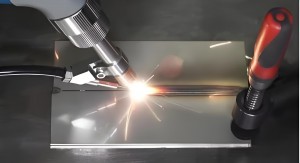In modern manufacturing, the 1500W handheld laser welding machine is highly favored due to its efficient, precise, and flexible features. The welding thickness of different materials is the key to its application.
Stainless steel is widely used in fields such as kitchenware and medical devices. The 1500W handheld laser welding machine can stably weld plates under 3mm for common stainless steel grades, such as 304 and 316. The welding effect is particularly good for 1.5mm - 2mm thickness. For example, a certain stainless steel sink production enterprise uses it to weld 2mm thick plates, with tight weld seams and a smooth surface; a medical device manufacturer welds 1.8mm thick components, ensuring the safety of the devices.
Aluminum alloys are widely applied in aerospace and automotive manufacturing. This welding machine can weld aluminum alloys with a thickness of about 2mm. The actual operation is somewhat challenging and requires precise parameter settings. In automotive manufacturing, aluminum alloy plates of about 1.5mm can achieve reliable connections. For instance, a well-known automotive brand welds a 1.5mm thick frame to achieve automotive lightweighting. In the aerospace field, aircraft component manufacturers use it to weld 1.8mm thick aluminum alloy skins.
Carbon steel is common in mechanical manufacturing and the construction industry. This welding machine can weld a thickness of about 4mm. In bridge construction, welding 3mm thick steel plates can ensure the stability of the structure; large mechanical manufacturing enterprises weld 3.5mm thick carbon steel structural components, improving efficiency and quality.
Although copper materials have good electrical conductivity and thermal conductivity, welding is difficult. The 1500W handheld laser welding machine can weld a thickness of about 1.5mm. In the electronic and electrical industry, a certain electronic product production line successfully welds 1mm thick copper sheets, and a power equipment manufacturer welds 1.2mm thick copper busbars to ensure stable power transmission.
With the continuous progress of technology, the future development trend of the laser welding machine industry is highly anticipated. On the one hand, continuous technological innovation will continuously increase the power of the welding machine, enabling it to weld thicker materials and expand its application range. On the other hand, the degree of intelligence and automation will be significantly enhanced. Through integration with technologies such as artificial intelligence and big data, more precise welding parameter control and quality monitoring can be achieved. At the same time, the in-depth concept of green environmental protection will prompt laser welding machines to make greater progress in energy conservation, reduction of material waste, and reduction of environmental pollution. In addition, multi-material composite welding technology is expected to achieve a breakthrough to meet the manufacturing needs of more complex structures and high-performance products.
It should be noted that the actual welding thickness is affected by many factors, such as the surface condition of the material and the welding speed. Operators need to optimize the process according to the specific situation. In conclusion, rational application can bring more possibilities to the manufacturing industry.


Post time: Jun-19-2024


